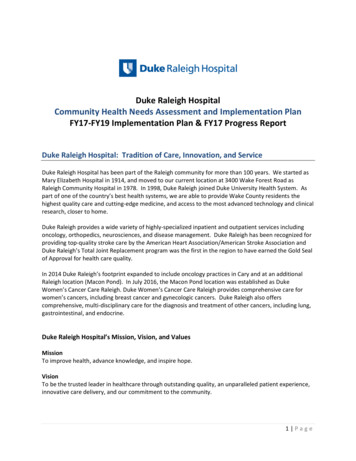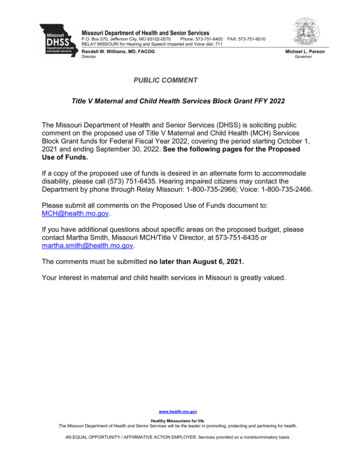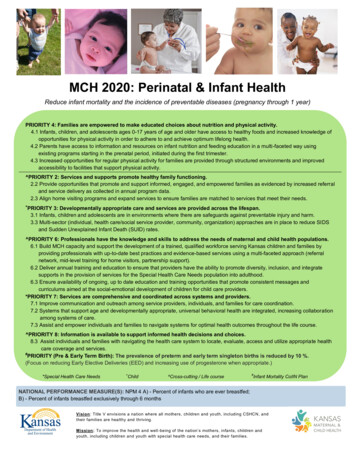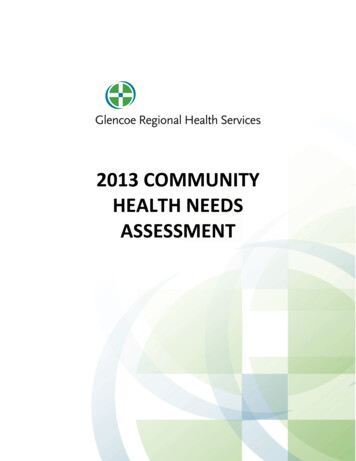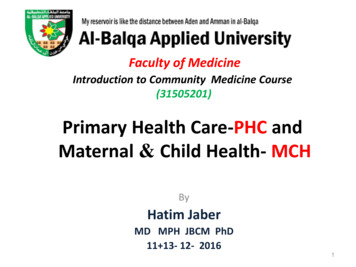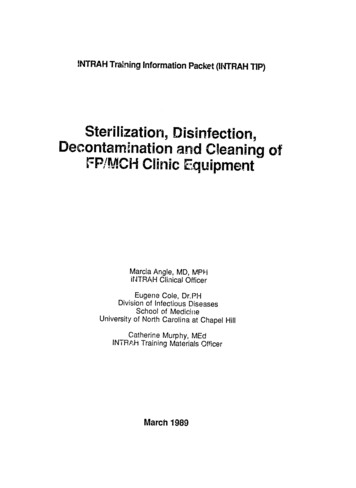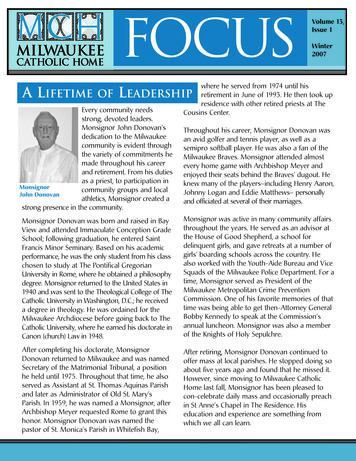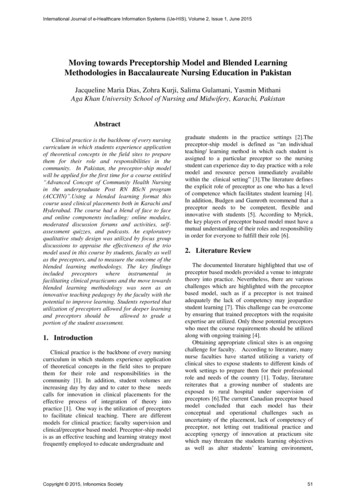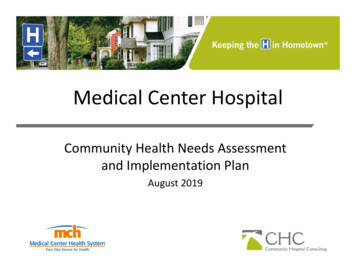
Transcription
Medical Center HospitalCommunity Health Needs Assessmentand Implementation PlanAugust 2019
Table of ContentsSection 1: Community Health Needs Assessment . 2Executive Summary . 3Process and Methodology . 9Hospital Biography . 15Study Area . 20Demographic Overview . 22Health Data Overview . 41Phone Interview Findings . 82Family Health Clinic: Patient Survey Analysis. 99Input Regarding the Hospital’s Previous CHNA . 115Evaluation of Hospital’s Impact. 117Previous Prioritized Needs . 1442019 CHNA Preliminary Health Needs . 146Prioritization . 148Priorities That Will Not Be Addressed . 153Resources in the Community . 155Information Gaps . 185About Community Hospital Consulting . 187Appendix . 189Summary of Data Sources . 190Data References . 193MUA/P and HPSA Information . 195Interviewee Information . 203Family Health Clinic Survey . 206Section 2: Implementation Plan .209Section 3: Feedback, Comments and Paper Copies .228Input Regarding the Hospital’s Current CHNA . 229Medical Center Hospital Community Health Needs Assessment and Implementation PlanCommunity Hospital ConsultingAugust 2019Page 1
Section 1:Community Health Needs AssessmentMedical Center Hospital Community Health Needs Assessment and Implementation PlanCommunity Hospital ConsultingAugust 2019Page 2
EXECUTIVE SUMMARYMedical Center Hospital Community Health Needs Assessment and Implementation PlanCommunity Hospital ConsultingAugust 2019Page 3
Executive SummaryA comprehensive, six‐step community health needs assessment (“CHNA”) was conducted for Medical Center Hospital (MCH) and the FamilyHealth Clinic (FHC) by Community Hospital Consulting (CHC Consulting). This CHNA utilizes relevant health data and stakeholder input toidentify the significant community health needs in Ector County, Texas.The CHNA Team, consisting of leadership from MCH and the FHC, met with staff from CHC Consulting on April 30, 2019 to review the researchfindings and prioritize the community health needs. Eight significant community health needs were identified by assessing the prevalence ofthe issues identified from the health data findings combined with the frequency and severity of mentions in community input.The CHNA Team participated in a prioritization process using a structured matrix to rank the community health needs based on threecharacteristics: size and prevalence of the issue, effectiveness of interventions and their capacity to address the need. Once this prioritizationprocess was complete, MCH and FHC leadership discussed the results and decided to address all of the prioritized needs in various capacitiesthrough hospital and clinic specific implementation plans.The eight most significant needs, as discussed during the April 30th prioritization meeting, are listed below:1.) Access to Primary Care Services and Providers2.) Access to Specialty Care Services and Providers3.) Access to Mental and Behavioral Health Care Services and Providers4.) Prevention, Education and Services to Address High Mortality Rates, Chronic Diseases, Preventable Conditions and Unhealthy Lifestyles5.) Improved Availability of Safe, Affordable Housing6.) Access to Affordable Care and Reducing Health Disparities Among Specific Populations7.) Increased Emphasis on Sex Education, Communicable Disease Prevention and Family Planning8.) Access to Dental Care Services and ProvidersOnce this prioritization process was complete, MCH leadership discussed the results and decided to address six of the eight prioritized needsin various capacities through its implementation plan. While MCH acknowledges that these are significant needs in the community, “ImprovedAvailability of Safe, Affordable Housing” and “Access to Dental Care Services and Providers” are not addressed largely due to the fact that theyare not core business functions of the hospital and the limited capacity of the hospital to address these needs. MCH will continue to supportlocal organizations and efforts to address these needs in the community.MCH leadership has developed the following implementation plan to identify specific activities and services which directly address theremaining priorities. The objectives were identified by studying the prioritized health needs, within the context of the hospital’s overallstrategic plan and the availability of finite resources. The plan includes a rationale for each priority, followed by objectives, specificimplementation activities, responsible leaders, annual updates and progress, and key results (as appropriate). Please see the ImplementationPlan section of this report for further information.The MCH Board reviewed and adopted the 2019 Community Health Needs Assessment and Implementation Plan on August 6, 2019.Medical Center Hospital Community Health Needs Assessment and Implementation PlanCommunity Hospital ConsultingAugust 2019Page 4
Priority #1: Access to Primary Care Services and ProvidersSeveral interviewees noted that there is an increasing need for additional primary care provider and nurses due to difficulty withrecruitment and retainment of such health care professionals. It was mentioned that the shortage of primary care providers leads to increaseduse of advanced practitioners, long wait times for appointments, and overuse of the ER for non‐emergent issues. One interviewee stated: “Weneed more doctors and nurses. There is a need for more access to medical care for people living out in the outer area.”Interviewees mentioned that there are limited primary care options in the community for un/underinsured, Medicaid and low incomeresidents. It was also noted that there is a general lack of emphasis on the importance in establishing a medical home, and one intervieweespecifically stated: “We do not have that medical home concept. People don’t know how to help themselves or their children when it’s 2am,so they go to the ER.”Interviewees mentioned a growing need for more providers offering and encouraging immunizations in the community, as well asfrustration with the current hospitalist model and the inability of patients to see their personal provider in the hospital. One intervieweestated: “Most people do not feel comfortable with hospitalists because you get the hospitalist of the day, so you get a new doc every day. Thatmakes it hard to maintain consistent health care, especially when somebody is in the hospital.”Findings from the 2019 Family Health Clinic survey indicate that the majority of respondents go to the Family Health Clinic when they aresick or need to see a doctor; however, the percentage of patients using the Family Health Clinic for care decreased between 2016 and 2019.Additionally, patients who indicated they go to a doctor at a different facility increased between 2016 and 2019.Priority #2: Access to Specialty Care Services and ProvidersSeveral interviewees noted that there is a shortage of specialty care providers leading to physician burnout and departure from thecommunity. Interviewees suggested the use of telemedicine for specialty care to help connect patients and providers with specialists who arenot in the community. It was also discussed that there is an increasing number of specialty care providers nearing retirement age, with oneinterviewee specifically stating: “Some of our providers are aging out and we’re having a hard time finding physicians to replace them.”Interviewees noted that patients tend to leave Ector County specialty care in more urban areas. Specific specialties mentioned as neededinclude: Orthopedics, Pediatric subspecialties, Trauma, Dermatology, Cardiology, Oncology, ENT, Rheumatology, Emergency Care and PainManagement. It was also noted that there is a limited number of local specialists accepting county assistance program, Medicare andMedicaid patients. One interviewee specifically stated: “There are a few specialists who take our county assistance patients, most don’t. Wehave a problem getting them in.”Priority #3: Access to Mental and Behavioral Health Care Services and ProvidersEctor County has a lower rate of mental health care providers per 100,000 population than the state.Interviewees mentioned that there are limited local mental and behavioral health care services and providers in the community, whichleads to the transferring of patients to places like San Angelo and Big Spring. It was also mentioned that law enforcement is typically used totransfer patients outside of the county, which takes officers off the road for several hours. One interviewee stated: “Our law enforcementofficers have to drive to San Angelo or Big Spring to transfer a patient who has mental health issues. That’s taking an officer off the street for5‐6 hours.”Interviewees raised concern surrounding the unmet mental and behavioral health needs in youth and pediatric residents, as well as anoverall shortage of providers resulting in long wait times. It was also mentioned that residents have difficulty identifying providers accepting Medical Center Hospital Community Health Needs Assessment and Implementation PlanCommunity Hospital ConsultingAugust 2019Page 5
Priority #3: Access to Mental and Behavioral Health Care Services and Providers (continued) insurance types due to limited promotion of such providers and whether or not they accept different coverage types. One intervieweestated: “If they won’t accept your insurance, you have to find other programs. There’s nothing on mental health out there. You have to findsomething.”Several interviewees noted the lack of substance abuse treatment facilities in the community, as well as increasing concerns among theyouth population that include marijuana use, anxiety, stress and depression. It was noted that there is a stigma associated with seeking carefor mental and behavioral health related concerns, which leads to a lack of utilization of available resources. One interviewee stated: “Wehave seen an increase in people that need mental health services and we’re referring them, but those people aren’t necessarily making it tothose places. It’s just a lot of shame and not feeling comfortable at those offices.”Priority #4: Prevention, Education and Services to Address High Mortality Rates, Chronic Diseases, PreventableConditions and Unhealthy LifestylesData suggests that higher rates of specific mortality causes and unhealthy behaviors warrants a need for increased preventive educationand services to improve the health of the community. Heart disease and cancer are the two leading causes of death in Ector County and thestate. Ector County has higher mortality rates than Texas for diseases of heart, malignant neoplasms, chronic lower respiratory diseases,accidents (unintentional injuries), Alzheimer’s disease, cerebrovascular disease, diabetes mellitus, chronic liver disease and cirrhosis,septicemia, intentional self‐harm (suicide), female breast cancer, lung and bronchus cancer, and colon and rectum cancer.Ector County has higher rates of chronic conditions and unhealthy lifestyle behaviors such as diabetes (Medicare population), obesity,asthma, physical inactivity, binge drinking and tobacco use than the state. Data also suggests that residents may not be seeking necessarypreventive care services, such as mammograms, prostate cancer screenings, colon cancer screenings, and flu shots (adults 18‐64 years of age).Several interviewees mentioned a lack of access to healthy food options in the community, as well as an increasing number of fast foodrestaurants. It was noted that these two factors lead to increased health care costs, obesity, diabetes, and heart disease. One intervieweestated: “We have more fast food restaurants because of the oil fields. With obesity, there’s a lot of underlying chronic diseases diabetes,heart disease, cancers, all types of diseases that are going to have a large impact on the future population.”It was mentioned that the community has a limited built environment and motivation to be physically active. Interviewees also noted thatthe higher cost of healthy lifestyle programs in the community results in lower participation rates, with one interviewee stating: “A lot ofcolleges and hospitals promote healthy lifestyles, but organizations don’t make it cheap. If it was affordable to obtain, more people wouldparticipate.”Interviewees discussed higher rates of diabetes in Hispanic and African American residents, and a growing problem of childhood obesity. Itwas also mentioned that there is a limited parental understanding of how to manage asthma and diabetes in children. One intervieweespecifically stated: “We are constantly teaching parents how to take care of children with asthma or diabetes. We have to give instructions at a5th grade level many have not finished high school and it is hard for them to understand how to manage chronic illnesses.”Priority #5: Access to Affordable Care and Reducing Health Disparities Among Specific PopulationsEctor County has a higher rate of uninsured adults than the state, and a higher percentage of adults with no personal doctor than the state.The county also has a higher rate of preventable hospital events per 1,000 Medicare Enrollees than the state. Ector County has severalgeographic‐ and population‐based Health Professional Shortage Area designations and census tract‐based Medically Underserved Medical Center Hospital Community Health Needs Assessment and Implementation PlanCommunity Hospital ConsultingAugust 2019Page 6
Priority #5: Access to Affordable Care and Reducing Health Disparities Among Specific Populations (continued) Area/Population designations, as defined by the U.S. Department of Health and Human Services Health Resources and ServicesAdministration (HRSA).Interviewees discussed affordability and cost barriers as concerns that disproportionately affect un/underinsured populations in thecommunity, resulting in overuse of the ER (specifically by Hispanic and un/underinsured residents), fewer residents with established medicalhomes, and lack of necessary preventive care services. It was mentioned that the overcrowding in the ER is leading to frustration with non‐emergent cases and long wait times, and that there is a perception in the community that emergency care is the quicker option due to a lackof extended hour facilities. One interviewee specifically stated: “I had a neighbor whose daughter had an ear infection and they called anambulance because they thought it’d be faster to get in. It’s just timing – late at night, early in the morning, weekends maybe where youwant to go isn’t open so the place you’re stuck with is the hospital.”Interviewees also noted that there is a limited number of providers accepting Medicaid, CHIP and Medicare patients in the community.Additionally, the lack of affordable medications and health care services in Ector County is forcing elderly residents to be noncompliant withtreatment plans. One interviewee stated: “Health care is easy to cut out of your budget. The senior population is only taking their medicineevery third day because they can’t afford the medicine for whatever it is they’re afflicted by.”When asked about which specific groups are at risk for inadequate care, interviewees spoke about pediatric, youth, elderly, homeless, lowincome/working poor, homeless, racial/ethnic and veteran populations as being disproportionately challenged by barriers to accessinghealthcare services in Ector County.With regards to the pediatric population, interviewees mentioned a lack of primary and specialty care options, ADHD and seizuredisorders, and obesity and diabetes as challenges for this particular population. For youth residents, interviewees mentioned substance use;anxiety, stress and depression; obesity; high drop out rates due to opportunities to work in the oil field; outmigration of patients for treatmentof ADHD, dyslexia, and autism; and a high rate of teen pregnancy and sexually transmitted infections as challenges for the youth community inEctor County.When speaking about the elderly population in Ector County, interviewees raised concern surrounding a need for health care advocatesand interpreters, the growing aging population, limited availability of affordable resources, lack of hospice care options, difficulty accessingand navigating the health care system and transportation barriers as issues for such residents. With regards to the low income/working poorgroup, interviewees noted limited access to wound care services, a lack of access to mental health care services, overuse of the ER,transportation barriers and a limited number of primary care options as challenges for these residents.For homeless residents, interviewees mentioned transportation barriers and mental and behavioral health care needs as issues for suchresidents. For racial/ethnic group residents, interviewees mentioned that Hispanic residents are disproportionately challenged byoutmigration to Mexico for health care services and medications, language barriers, overuse of the ER, diabetes and childhood obesity, andAfrican American residents are challenged by higher rates of diabetes.Lastly, for veterans, interviewees mentioned frustration with the VA system and limited local care options as challenges for such residents.Priority #6: Increased Emphasis on Safe Sex Education, Communicable Disease Prevention and Family PlanningEctor County has higher rates of communicable diseases (chlamydia, gonorrhea) than the state. With regards to maternal and child health,specifically, Ector County has higher percentages of mothers smoking during pregnancy, low birth weight births, and teen births than the state,with higher percentages of repeat births to teens and births to single teens than the state.Medical Center Hospital Community Health Needs Assessment and Implementation PlanCommunity Hospital ConsultingAugust 2019Page 7
Priority #6: Increased Emphasis on Safe Sex Education, Communicable Disease Prevention and Family Planning(continued)Interviewees mentioned that there is an increasing rate of teen births who are not receiving adequate, timely prenatal care, as well as aperception that there is a normalization of births to younger teens. There is also growing concern regarding the limited local access to familyplanning services and resources, and one interviewee stated: “Access to family planning services is not available here. Anyone who lives inWest Texas has very limited access to subsidized services for family planning.”Several interviewees discussed higher rates of sexually transmitted infections, specifically chlamydia, in the community, as well as the lackof community outreach regarding sex education, communicable disease prevention and family planning. It was noted that low income andun/underinsured residents may have a greater challenge in seeking family planning assistance programs, and interviewees discussed concernsurrounding parental irresponsibility and limited proper parenting skills in the community. One interviewee specifically stated: “ parents arenot available when [the school nurse] calls them so we call 911. Parents are not aware of their responsibilities and it becomes an emergency.”Medical Center Hospital Community Health Needs Assessment and Implementation PlanCommunity Hospital ConsultingAugust 2019Page 8
PROCESS AND METHODOLOGYMedical Center Hospital Community Health Needs Assessment and Implementation PlanCommunity Hospital ConsultingAugust 2019Page 9
Process and MethodologyBackground & Objectives This CHNA is designed in accordance with CHNA requirements identified in the PatientProtection and Affordable Care Act and further addressed in the Internal Revenue Service finalregulations released on December 29, 2014. The objectives of the CHNA are to:– Meet federal government and regulatory requirements– Research and report on the demographics and health status of the study area, including a review of state andlocal data– Gather input, data and opinions from persons who represent the broad interest of the community– Analyze the quantitative and qualitative data gathered and communicate results via a final comprehensive reporton the needs of the communities served by MCH– Document the progress of previous implementation plan activities– Prioritize the needs of the community served by the hospital– Create an implementation plan that addresses the prioritized needs for the hospitalMedical Center Hospital Community Health Needs Assessment and Implementation PlanCommunity Hospital ConsultingAugust 2019Page 10
Process and MethodologyScope The CHNA components include:– A description of the process and methods used to conduct this CHNA, including a summary of data sources usedin this report– A biography of MCH– A description of the hospital’s defined study area– Definition and analysis of the communities served, including demographic and health data analyses– Findings from phone interviews collecting input from community representatives, including: State, local, tribal or regional governmental public health department (or equivalent department or agency) withknowledge, information or expertise relevant to the health needs of the community; Members of a medically underserved, low‐income or minority populations in the community, or individuals ororganizations serving or representing the interests of such populations Community leaders– Findings from a community survey that collected input from Family Health Clinic patients– A description of the progress and/or completion of community benefit activities documented in the previousimplementation plan– The prioritized community needs and separate implementation plan, which intend to address the communityneeds identified– Documentation and rationalization of priorities not addressed by the implementation plan– A description of additional health services and resources available in the community– A list of information gaps that impact the hospital’s ability to assess the health needs of the community servedMedical Center Hospital Community Health Needs Assessment and Implementation PlanCommunity Hospital ConsultingAugust 2019Page 11
Process and MethodologyMethodology MCH worked with CHC Consulting in the development of its CHNA. MCH provided essential dataand resources necessary to initiate and complete the process, including the definition of thehospital’s study area and the identification of key community stakeholders to be interviewed.CHC Consulting conducted the following research:– A demographic analysis of the study area, utilizing demographic data from the IBM Watson Health Market ExpertTool and local reports– A study of the most recent health data available– Conducted one‐on‐one phone interviews with individuals who have special knowledge of the communities, andanalyzed results– Facilitated the prioritization process during the CHNA Team meeting on April 30, 2019. The CHNA Team included: Christin Abbott‐Timmons, Divisional Director Women & Children Services/SANE Nursing at Odessa Medical CenterHospital David Garcia, FHC Executive Director and Director of Governmental Affairs Adiel Alvarado, Executive Director of ProCare Operations/Regional Services Lindsey Duncan, Director of Population/Community Health The methodology for each component of this study is summarized in the following section. Incertain cases methodology is elaborated in the body of the report.Medical Center Hospital Community Health Needs Assessment and Implementation PlanCommunity Hospital ConsultingAugust 2019Page 12
Process and MethodologyMethodology (continued)– MCH Biography Background information about MCH, mission, vision, values and services provided were provided by the hospital or taken from itswebsite– Study Area Definition The study area for MCH is based on hospital inpatient discharge data from May 1, 2018 – April 30, 2019 and discussions with hospitalstaff– Demographics of the Study Area Population demographics include population change by race, ethnicity, age, median income analysis, unemployment and economicstatistics in the study area Demographic data sources include, but are not limited to, IBM Watson Health Market Expert, Community Commons, the Annie E. CaseyFoundation Kids Count Data Center, the U.S. Census Bureau, the United States Bureau of Labor Statistics, the Odessa DevelopmentCorporation, Feeding America, and the Texas Education Agency– Health Data Collection Process A variety of sources (also listed in the reference section) were utilized in the health data collection process Health data sources include, but are not limited to, the Robert Wood Johnson Foundation, Texas State Department of Health and HumanServices, the CARES Engagement Network, United States Census Bureau, and the Centers for Disease Control and Prevention– Interview Methodology MCH and FHC provided CHC Consulting with a list of persons with special knowledge of public health in Ector County, including publichealth representatives and other individuals who focus specifically on underrepresented groups From that list, 30 in‐depth phone interviews were conducted using a structured interview guide Extensive
Findings from the 2019 Family Health Clinic survey indicate that the majority of respondents go to the Family Health Clinic when they are sick or need to see a doctor; however, the percentage of patients using the Family Health Clinic for care decreased between 2016and 2019.



